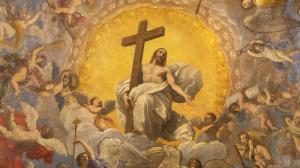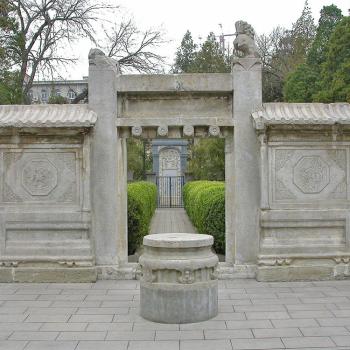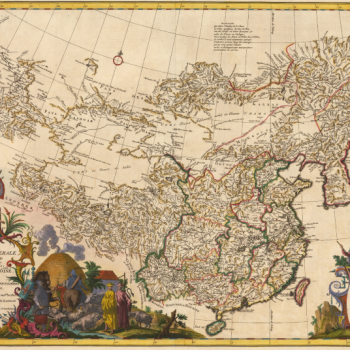
It should now be quite apparent that, from Zoroastrianism down through the rigid but somewhat unorthodox Judaism of the Dead Sea Scrolls, the coming of the messiah was expected to be the end of history, the culmination of the struggle between good and evil (however that was defined), and the final renovation of the world. All things would be made perfect and perhaps a new moral order might be established for eternity. It was, in short, always an eschatological idea, inevitably connected to the Last Days and the fulfillment of God’s final plan for the world and humanity.
Thus, to say that the messiah had come was also to say that the Last Days were beginning. The first necessarily entailed the second. Christianity, then, based upon the belief in Jesus Christ as the messiah, could not help but be eschatological in nature and focus. Jesus of Nazareth laid claim to the role of the Davidic messiah and Christianity as a whole has maintained that claim ever since. It has always been a risky venture; a cursory look back at the last several entries in this series will reveal how little the Jesus of the Gospels resembles the figure foretold in the Old Testament and the Dead Sea Scrolls. Indeed, Jesus’s insistence that “[m]y kingdom is not of this world” (John 18:36) renders him as the direct inverse of the traditional Davidic messiah, whose purpose is chiefly to restore Israel as an earthly kingdom and make her preeminent amongst the nations. And yet, the claim was important enough for Jesus, his disciples, and countless later Christians to die for.
It is impossible to know why Jesus chose to claim the Davidic mantle. Jesus was not born to the priesthood, so a claim to being a priestly messiah like the one expected by the Qumran sect may have been out of his reach. But he could still have laid claim to being the second Moses prophesized in Deuteronomy. That prophecy was evidently popular in first-century Judea, and claiming the role of a religious teacher who initiates a new covenant would line up far more with Jesus’s actual activities than the political and military maneuvering attributed to the Davidic messiah. Had he claimed to be the second Moses, the course of Christianity might have been considerable different. But for better or worse, Jesus made the Davidic claim, thereby setting the dividing line that has existed between Judaism and Christianity for just over two thousand years.
But while he might not have fit the specific qualifications of the Messiah from the line of David, Jesus did fulfill the broader messianic archetype in one particular way: he preached a message that the world’s renovation had begun and encouraging his listeners to take part. He did this by proposing a new kind of religion that differed markedly from the Jewish faith as he would have known it. Indeed, it was one that challenged the basic assumptions of Second Temple Judaism. While Jesus may have said that “I have come not to abolish, but to fulfill” the Jewish law (Matt. 5:17), abolition did not seem too far off from what he was trying to do.
He intervened in the dispute between the Jews and the Samaritans about the proper location of temple by declaring, “you will worship the Father neither on this mountain [Gerizim] nor in Jerusalem … But the time is coming, indeed it is already here, when true worshippers will worship the Father in spirit and in truth” (John 4:21-24). He challenged the Sabbath observances, stating, “The sabbath was made for man, not man for the sabbath” (Mark 2:27). Against the often very concrete image of God on his throne of majesty that was so prevalent at this time and soon to be perfected by the Merkavah mystics, Jesus insisted on God’s intangibility, “God is spirit, and those who worship him must worship in spirit and truth” (John 4:24). His interactions with the Samaritans and the post-resurrection injunction: “Go to every part of the world, and proclaim the gospel to the whole creation” (Mark 15:15) proclaimed that the whole world is to be the beneficiary of the messiah’s entrance into history, contrasting sharply with Jewish messianism’s exclusive focus on the land of Israel and taking some shine off the Jewish nation’s claim to being the “chosen people.” His promise that “the last shall be the first, and the first last” (Matt 20:16) and his warning that “[n]o one is worthy of me who cares more for father or mother more than me; no one is worthy of me who cares more for son or daughter” (Matt. 10:37) threatened to upend and reshape the whole social order, from the courts of kings and councils of state to the basic structure of the family unit. And, in addition to all of this, he made the claim of being God.
In short, everything about Jesus’s message seemed designed to challenge the pieties and doctrines of Second Temple Judaism. It is possible—indeed, from a strictly historical perspective, even probable—that Jesus saw himself as returning Israel to an earlier, more pristine form of Judaism. But the new covenant that he laid out was one which, if followed to the letter by everyone, would reshape Judaism and make it into something far different from what it was. In short, Jesus was inviting his listeners into a new type of society, one which had not existed previously in the history of the Jewish nation or, indeed, in any nation.
Jesus probably found his warrant for this in the Book of Jeremiah. As demonstrated in a previous entry, that book links the coming of the messiah and the establishment of the new covenant with a complete transformation of the social order: “For the Lord has created a new thing in the earth: a woman will play a man’s part” (Jer. 31:22). By taking these words to heart, Jesus could see himself as faithful to the law while also expecting that a very different kind of society would emerge in the Last Days and that it was his job to call this society into being.
This is an important point. Jesus was not just a prophet, revealing the form and appearance of the future social order that would prevail when God’s kingdom came to earth. He was actively asking his followers to follow the precepts and live the life of that future kingdom even though it had not yet become an earthly reality. In effect, he was asking them to become the first manifestation of the Kingdom in the world, to lead the way toward the great social transformation that was to come. Through them, a radical reworking of the social order was already in effect and the long-foretold renovation of the earth was on the path toward completion. The rebirth of the world was underway and the all the old social systems with their many injustices were soon to crumble and cease to be.
And this would all happen very soon indeed. The power of Jesus’s message in the gospels comes from its sense of urgency. His coming has initiated the last days, and thus everyone had better start living the life of the future Kingdom, lest its arrival sneak up on them. Jesus fully reproduced all the old notions about the messiah’s advent coinciding with the end of history. His statements that “there are some of those standing here who will not taste death before they have seen the Son of Man coming in his kingdom” (Matt. 16:28) and “before you have gone through all the towns of Israel the Son of Man will have come” (Matt. 10:23) point to a clear understanding that the time remaining until the final establishment of the millennial kingdom is short; it can only be a few years at most. This is also reflected in the New Testament’s great apocalyptic work, the Book of Revelation. John of Patmos’s choice to preface his vision of the end with exhortations to the seven churches makes sense only if the Last Days and the churches’ need for spiritual strengthening are interconnected. Therefore, there is intense pressure on the followers of Jesus; through their lifestyle and conversion work they must begin conquering the world for the Kingdom. In the limited time remaining, they must move the world away from the old, corrupted systems of power, ethics, and social organization and toward the inevitable and fast-approaching direct rule of God. This not only cultivates an incredible zeal to oppose all things not belonging to the messianic design but also an incredible sense of haste to get the work done in time.
Christianity as originally practiced encourages an uncompromising stance of opposition to the corrupted things of this world and an intense desire to clear those things away. All that Christians are to do is aimed toward establishing the Kingdom on earth. It is thus a radical, even revolutionary faith, one that brooks no tolerance or compromise with the systems and social structures already in place, instead seeking to turn them upside down. It is a call to action against everything that is wrong in the world and a reminder that time is short to make it right. It is with this perspective in mind that we can begin to understand the early Christians’ staunch, world-denying asceticism and the enthusiasm they had for dying on behalf of Christ’s message. Both of these things were ways of manifesting God’s kingdom in the world, of launching the final renovation in which all human social structures would be completely transformed.
It may be somewhat hard to accept this reading of early Christianity, given that it accords so poorly with what many people today have experienced of the faith. Most have come to think of Christianity as a religion primarily concerned with the individual and the particular fate of their soul. This goes along with the common understanding of Christianity’s development. Most modern scholarship presupposed that Jesus’s brand of messianism closely followed the political and militaristic expectations of the Old Testament but that, after his death kept those old prophecies of conquest and empire from being fulfilled, his disciples chose to spiritualize his messianic mission and make him into the transcendent savior of individual souls rather than the revolutionary founder of a new kind of human society.
That this change in perspective did happen in Christianity at some point is beyond dispute. It is already evident in the first few Christian centuries, as demonstrated by a scene in the Sayings of the Desert Fathers in which St. Antony the Great (d. 352) asks God about why suffering and injustice are allowed to exist and is given the petulant reply, “Antony, worry about yourself; these other matters are up to God, and it will not do you any good to know them” (Desert Fathers 148). However, this development was not in any way the necessary or inevitable outcome of Christianity spiritualizing the messiah concept. As we have seen, the Book of Jeremiah had already spiritualized messianism by suggesting that the new covenant would involve a transformation in the soul of the believers themselves, “I shall set my law within them, writing it on their hearts” (Jer. 31:33). Yet, this personal and spiritual transformation went hand in hand with a complete social transformation; they were simply two sides of the same process. Similarly, the Qumran community of the Dead Sea Scrolls had an obsession with individual sin, repentance, and penitence that almost puts pre-modern Christianity to shame. Yet their understanding of salvation was resolutely communal; the initiate may have to worry about his own soul’s redemption, but this was because he needed to maintain his standing in the community of the elect and help them to fulfill God’s plan of redeeming Israel. The personal transformation was always at the service of the wider, communal one.
Thus, there was nothing about Christianity’s potentially excessive focus on individual sinfulness and the need for personal salvation that necessarily required an uprooting of its social vision be uprooted. Indeed, just as with Jeremiah and the Qumran sect, the early Christians viewed both as simply different aspects of a single, all-encompassing work of redemption. Scholars generally favor the view that Christians of the first century did not believe in an afterlife in Heaven immediately following this life’s conclusion—although the idea was current in Judaism at the time, with the Qumran sect among its adherents—but rather expected their reward to come at the resurrection of the saints when Christ established his thousand-year rule on earth, as foretold in Revelation, “I saw the souls of those who, for the sake of God’s word and their witness to Jesus, had been beheaded, those who had not worshipped the beast and its image or received its mark on forehead and hand. They came to life again and reigned with Christ for a thousand years” (Rev. 20:40). It was by having a place in this community of a revitalized and purified earth, by being simply one part of a revitalized and purified humanity, that the righteous would find their reward.
It was only after this thousand-year reign, the Millennium, failed to quickly materialize that the shift toward the modern view of an individual judgment and an immediate period of bliss in Heaven began to occur. As Peter Müller-Goldkuhle observes in “Post-Biblical Developments in Eschatological Thought,” “When the broader eschatological perspectives became blurred, the eschatological expectations of the individual took on greater significance … The fate of the individual soul became the center of attention” (Müller-Goldkuhle 27). As such, something very important was lost, namely, the inherent link that Christianity presented between the salvation of individual souls and the rebirth of the created order, first in the Millennium and then in the “new heaven and a new earth” (Rev. 21:1) of eternity.
The most useful thing about Christianity had been, from a broader social perspective, that it had shaken everything up. It inevitably called into question the conventional pieties and established truths of every society it had entered. It called society to account for its injustices toward the poor, the sick, and other outcasts and insisted that there was a remedy for these injustices in the joyful advancement of God’s kingdom on earth. However, when the link between individual and society was broken, the revolutionary potential of Christianity was lost and the best thing about the faith went dormant for roughly a thousand years.
But that did not mean that it was not still there, under the surface, ready to be taken up again. Indeed, if this revolutionary potential, this call to take up the task of making the world more like the Kingdom, is at the heart of Christianity, then it behooves practicing Christians who take their faith seriously to rediscover it. As Jürgen Moltmann emphasizes in his Theology of Hope, the fact that “the Christian community does not live from itself and for itself but … for the coming sovereignty of him who has conquered death and is bringing life, righteousness, and the kingdom of God” (325) necessarily makes this rediscovery the responsibility of believing Christians and the Christian church as a whole: “The Christian Church has not to serve mankind in order that this world may remain what it is, or may be preserved in the state in which it is, but in order that it may transform itself and become what it is promised to be” (327). The Christian doctrine is not simply a set of intractable laws and precepts, but a handbook for living the life of the messianic kingdom and for helping to manifest that kingdom on earth. Given that so much of Christianity’s current decline has been the result of its insistence on a rigid dogmatism that leaves it unable to minister to society’s present needs, a renewed commitment to the faith’s original, revolutionary messianism among contemporary Christians might be the only thing that offers a chance of turning the religion of Christ’s flagging fortunes around. It at the very least seems worth a try.
And for any who think this is too great a task to expect of Christianity today, it should be noted that it has been done before. In the twelfth century, after a thousand years of an aggressively personalist approach to Christianity, the faith’s revolutionary social meaning was revived with gusto. And while the resulting movement occupied an uneasy place between official orthodoxy and prohibited heresy—indeed, it counted both future Catholic saints and individuals condemned as heretics among its adherents—it is not too much to say that much of Christianity’s success over the last eight-hundred years was due to the revitalization of the faith it achieved. The intellectual father of this movement is, despite his best efforts. surely one of the most controversial individuals to have ever emerged from the ranks of the Catholic Church. But however much revered theologians like Bonaventure and Thomas Aquinas assailed him, it may be said that, given how his vision of a new age revived the radically transformative potential of Christianity’s original messianism, Joachim of Fiore was by far the truest Christian to have existed in a thousand years.
Works Cited and a Note on Sources
For the frequent quotations of Biblical verses, I have relied upon the Oxford Study Bible (New York: Oxford University Press, 1992), except in the first two instances—“My kingdom is not of this world” and “not to abolish, but to fulfill”—where this edition departs from the standard rendering of those verses. Since the commonly received rendering is so well-known, I have opted to make use of it instead in both cases. Otherwise, the verses I have quoted can be found in:
The Gospel according to Matthew. The Oxford Study Bible, edited by M. Jack Suggs, Katharin Doob Sakenfeld, and James R. Meuller. New York: Oxford University Press, 1992. 1267-1303.
The Gospel according to Mark. The Oxford Study Bible, edited by M. Jack Suggs, Katharin Doob Sakenfeld, and James R. Meuller. New York: Oxford University Press, 1992. 1304-1326.
The Gospel According to John. The Oxford Study Bible, edited by M. Jack Suggs, Katharin Doob Sakenfeld, and James R. Meuller. New York: Oxford University Press, 1992. 1365-1393.
The Revelation of John. The Oxford Study Bible, edited by M. Jack Suggs, Katharin Doob Sakenfeld, and James R. Meuller. New York: Oxford University Press, 1992. 1556-1575.
I am well-aware that Biblical scholarship has revealed the tangled provenance of the New Testament works and raised questions about what, if anything, can be attributed to the historical Jesus. But I have chosen to work on the assumption that the Gospels at least convey something of Jesus’s original teachings and that quoting from them helps to illuminate what those teachings were.
As for my non-Biblical sources, I have cited:
The Desert Fathers: Sayings of the Early Christian Monks. Translated by Benedicta Ward. London: Penguin, 2003.
Müller-Goldkuhle, Peter. “Post-Biblical Developments in Eschatological Thought.” Concilium, vol. 41, “The Problem of Eschatology” (1969): pp. 42-56.
Moltmann, Jürgen. Theology of Hope. Translated by James W. Leitch. Minneapolis: Fortress Press, 1993.











